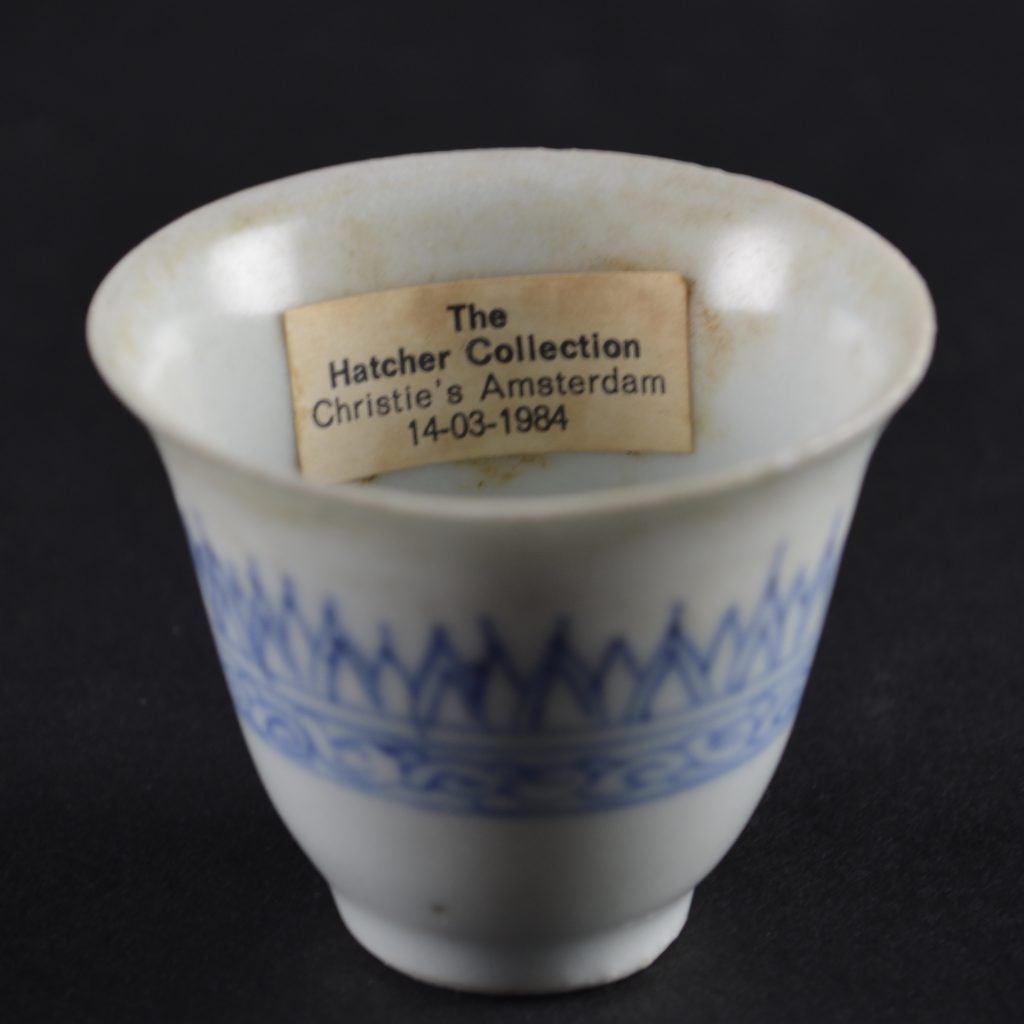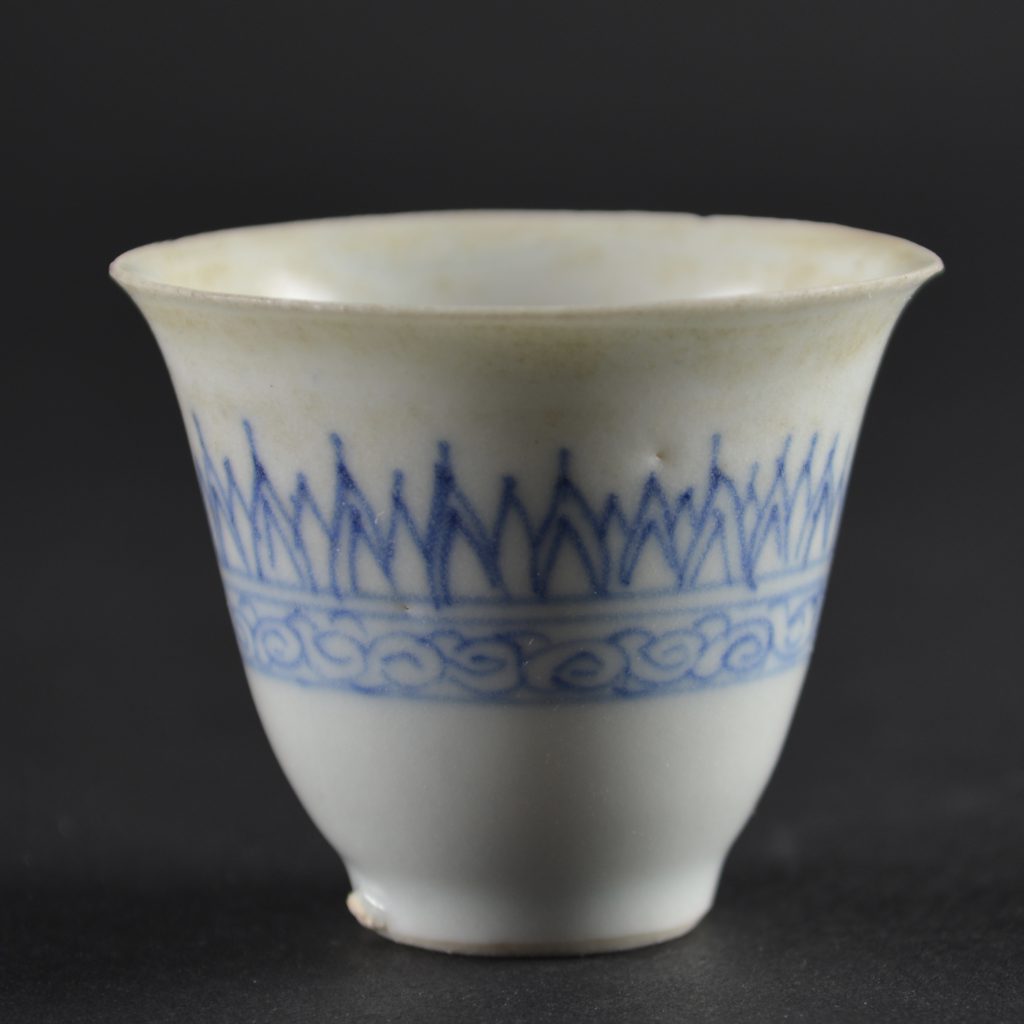
A Transitional Porcelain Wine Cup From The Hatcher Cargo
A Transitional Porcelain Cup from the Hatcher Cargo, Late Ming, Chongzhen c.1643. This cup is closely related to important ‘The Jamestown Cup’ the earliest piece of porcelain known to have been in America (see ‘Information’ below). There are other early American finds of this type of Ming cup from the period of 1630-1650. It is thought the cups of this type from early Colonial American sites came via the Dutch to England and then on to Virginia.
SOLD
- Condition
- In very good condition, two almost imperceptible glaze fits, some staining to the interior.
- Size
- Diameter 4.8 cm (2 inches) Height 4.1 cm (1 1/2 inches)
- Provenance
- Auction catalogue - Fine And Important Late Ming And Transitional Porcelain, Recently Recovered from an Asian Vessel in the South China Sea. Property of Captain Michael Hatcher. Christie`s Amsterdam 14th March 1984. Label to base.
- Stock number
- 25313
- References
- Auction catalogue - Fine And Important Late Ming And Transitional Porcelain, Recently Recovered from an Asian Vessel in the South China Sea. Property of Captain Michael Hatcher. Christie`s Amsterdam 14th March 1984.
Information
The James Town Cup c.1610
The Jamestown cup probably came from China to the Netherlands and from there to England, where it was acquired by one of the colonists who brought it to Virginia. It is possible that the cup came directly to Virginia via a Dutch ship; the Dutch were certainly there by 1619, when they brought the first enslaved Africans to Virginia, but might have been trading in Jamestown as early as 1611. This is the earliest piece of porcelain discovered in America.
The cup was probably owned by one of Jamestown’s wealthy colonists, a “gentleman,” who would have used it for drinking distilled wine such as brandy, which was known in the period as aqua vitae, or “water of life.” It is among a dozen similar cups dating to between 1610 and 1640 that have been found in Virginia. The presence of porcelain in a struggling settlement on what was, to Europeans, the edge of the known world shows just how desirable a commodity Chinese porcelain was.
Information and photograph http://www.chipstone.org


This example was recovered from the Walter Aston Site,
Charles City County, Virginia,
in a 1630–1650 context.

Another related Ming cup of the same pattern as the Jamestown Cup.

( Winterthur Museum, Museum purchase with funds provided by Mrs. Alfred P. Harrison.)
The Hatcher Cargo :
The Hatcher Cargo was the first porcelain cargo from a shipwreck to come on to the market. It was sold in several auctions in Christie`s Amsterdam in 1984 and 1985. It remains one of the most important cargoes of shipwreck ceramics ever recovered, despite the lack of historical evidence recorded by the salvage team. Two porcelain covers dated 1643 helped date the wreck but this needed corroborating to give a firm date of the wreck and it`s cargo.
The dating of the porcelain from the Hatcher Cargo is based on several elements. Firstly, the ceramics recovered form a coherent group, in other words they appear to all have been made at the same time. Secondly comparative dating was used to corroborate the date of the porcelain. For example, blue and white porcelain dishes decorated with a coiled serpent recovered from the Hatcher Cargo match an important dish from the fall of the Ming dynasty, formerly in the Percival David Foundation, now at the British Museum London, this dish can be dated to 1644 - 1645.
Other comparative dating is also consistent with the presumed date of the porcelain. However, the most important dating reference remains the two covers recovered from the wreck datable by inscription to the spring of 1643. Although the Ming dynasty officially ended in 1644 the transition from the Ming to the beginning of the Qing was messy and protracted. The porcelain made during this period of civil war and chaos is referred to as `Transitional Porcelain`. It covers the period from the last Ming Emperors until the early years of the Kangxi period, which is normally given a date of about 1620 to 1670 . The Hatcher Cargo is a vital dating tool for this previously poorly understood period of Chinese porcelain production.








